18 Types of Moth Caterpillars: A Visual Identification Guide
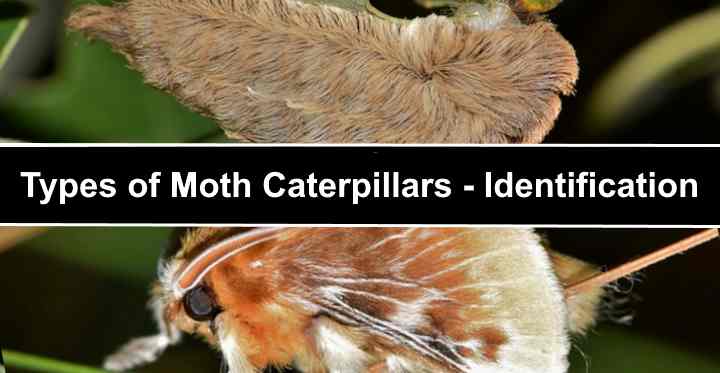
A moth caterpillar refers to the larval stage of a moth, which is the stage before it undergoes metamorphosis to become an adult moth. Moth caterpillars come in various shapes, sizes, and colors, and they feed on a wide range of plant materials depending on the specific species. During this stage, they primarily focus on consuming food to fuel their growth and development before they enter the pupal stage and eventually emerge as adult moths.
Moth caterpillars may have no resemblance to the adult moths. Knowing how to identify moth caterpillars can help you know the type of moth they turn into.
This article is a guide to identifying common types of moth caterpillars. Pictures and descriptions for many moth caterpillar varieties, including their behavior and identification characteristics, will help you recognize individual species of these crawling, worm-like creatures.
Moth Caterpillar Identification
The identifying features of moth caterpillars are their long, worm-like bodies, color, distinctive markings, presence of hairs, habitat, and plants they feed on. In addition, moth caterpillars have six legs and distinctive prolegs (stumpy false legs). After pupation, a moth caterpillar may look entirely different from the adult moth that emerges from the pupa.
For example, the unusual, white-marked tussock moth caterpillar has tufts of white hairs, and black and yellow body, and a distinctive orangey-red head. However, this caterpillar turns into an unremarkable grayish-brown furry moth.
Types of Moth Caterpillars (With Pictures) – Identification Guide
Here are some of the most common moth caterpillars with their pictures.
White-Marked Tussock Moth Caterpillar (Orgyia leucostigma)
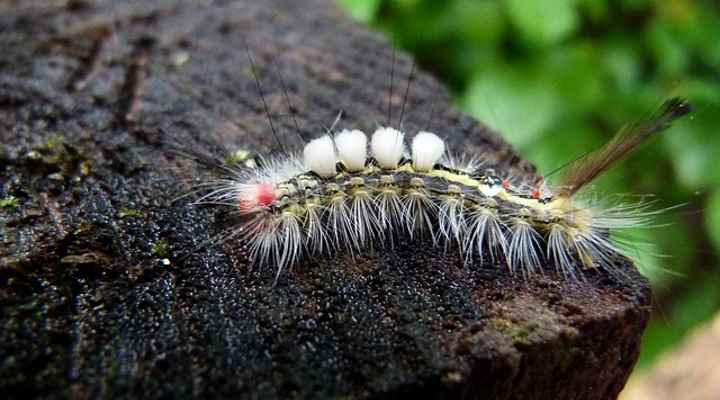
The furry white-marked tussock caterpillar
The white-marked tussock moth caterpillar is a furry yellow and black caterpillar. It grows 1.3” (35 mm) long. The spiny moth caterpillar is identified by its red head and toothbrush-like tufts of yellowish-white hairs on a yellow and black body. You’ll find the fuzzy moth caterpillar feeding on a range of deciduous and coniferous trees.
White-Marked Tussock Moth
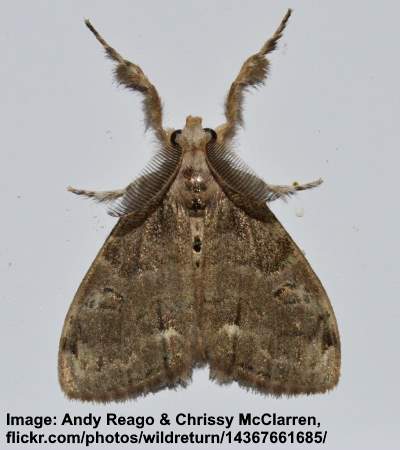
The white-marked tussock moth has an unassuming gray appearance with feathery antennae
The white-marked tussock moth is a gray, fuzzy moth with black lines and a white spot on each forewing. The male white-marked tussock moth is known for its feathery, or plumose, antennae.
The white-marked tussock moth caterpillar is a common caterpillar found in Florida.
- Adult Stage: Transforms into the white-marked tussock moth
- Caterpillar Feeds on: Feeds on the leaves of various trees and shrubs
- Habitat: Native to North America, often in forests, woodlands, and urban areas
- Stinging: White-marked tussock moth caterpillars possess mildly irritating spines but do not deliver severe stings
Isabella Tiger Moth Caterpillar (Pyrrharctia isabella)
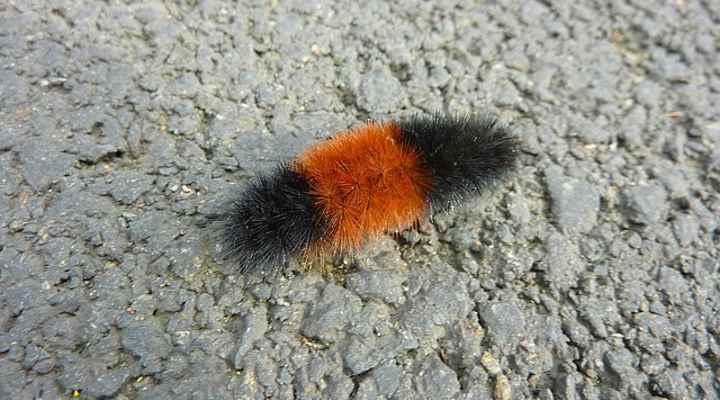
The Isabella tiger moth caterpillar is a furry caterpillar with black and orange or brown hairs
Also called the banded woolly bear, the Isabella tiger moth caterpillar is a furry, black and orange moth caterpillar with broad orange-rusty brown band around its mid-section, and furry black head and tail ends. The spiky moth larva measures 2.3” (60 mm) long. Covered in spines, the banded caterpillar may look menacing, but this insect doesn’t bite although it may cause skin irritation.
Isabella Tiger Moth
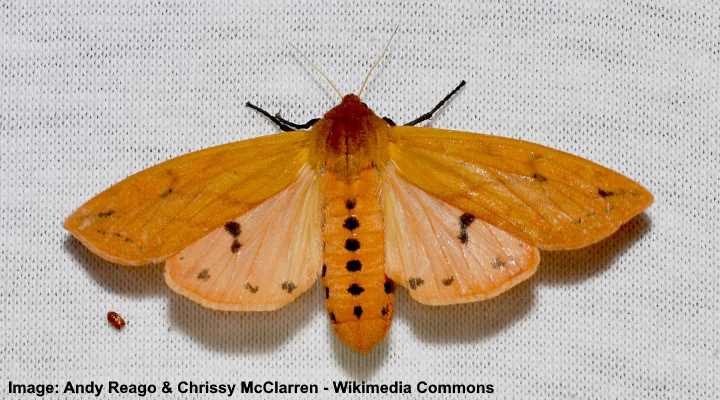
Isabella tiger moth has orange-yellow wings with black dots
The Isabella tiger moth, also known as the woolly bear moth, belongs to the family Erebidae. In its adult form, it is known for its medium size and distinct coloration. The wings of the Isabella tiger moth are usually a mix of creamy white and orange-brown, with some individuals exhibiting darker shades of brown or black. Its wingspan typically measures around 1.5 to 2 inches (3.8 to 5 centimeters).
- Adult Stage: The adult form of this caterpillar is the Isabella tiger moth
- Host Plants: Woolly bear caterpillars are known to feed on a variety of plants such as aster, clover, birch, maple, elm, sunflower, and corn
- Habitat and Distribution: They can be found in open fields, gardens, and meadows across North America, particularly in the United States and southern Canada
- Stinging: Handling one of these fuzzy worm-like creatures with their spiky tufts of hair may cause skin irritation or contact dermatitis
Ruby Tiger Moth Caterpillar (Phragmatobia fuliginosa)
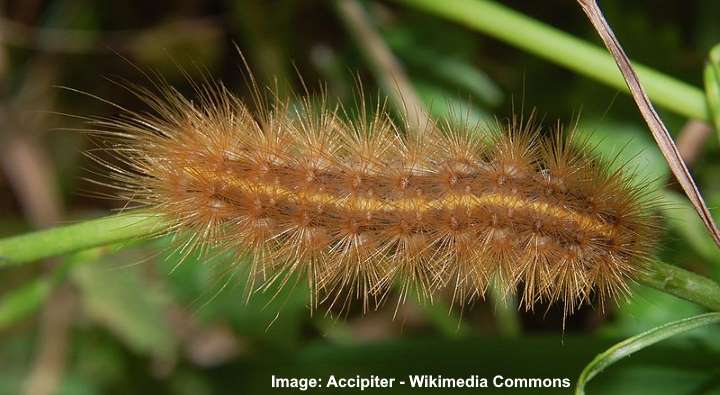
The ruby tiger moth caterpillar has orange-brown hairs and a yellow line along its back
The ruby tiger moth caterpillar is yellow and furry, with an orangey-brown body and a blackish-brown head. The fuzzy moth larva has recognizable tufts of foxy-red stinging hairs and spines and a yellow stripe down its back. Ruby tiger moth caterpillars grow 1.2” (30 mm) long.
Ruby Tiger Moth

The ruby tiger moth has furry head and reddish-pink wings with black spots
The ruby tiger moth is recognized for its deep ruby-red wings with intricate black or dark brown markings, creating a visually captivating contrast that aids in both identification and camouflage in its natural environment.
With a wingspan ranging from approximately 1 to 1.4 inches (2.5 to 3.5 centimeters), the ruby tiger moth is of medium size. Its forewings are predominantly deep ruby red, while the hindwings appear in a paler shade of red or pink. This striking color contrast makes it easily identifiable.
- Adult Stage: Ruby tiger moth, a furry reddish moth
- Caterpillar Feeds on: Foliage of willow shrubs, cabbage, berry bushes, broadleaf plantain, and clover
- Habitat: Found in areas where its host plants grow; primarily found in Europe, including the United Kingdom
- Stinging: No, they do not have stinging hairs
Rosy Maple Moth Caterpillar (Dryocampa rubicunda)

The light green striped rosy maple caterpillar has black dots and 2 black horns poking out from its head
The rosy maple moth caterpillar is a bright green caterpillar with a bulbous pale brown head, a pair of black antennae, and rows of spiny black dots along its abdomen. It also has red markings at its tail end. The plump green moth larva becomes darker as it matures and develops green, pale white, or black stripes along its body.
The fat green moth caterpillar measures about 2” (50 mm) before entering the pupal stage.
Rosy Maple Moth
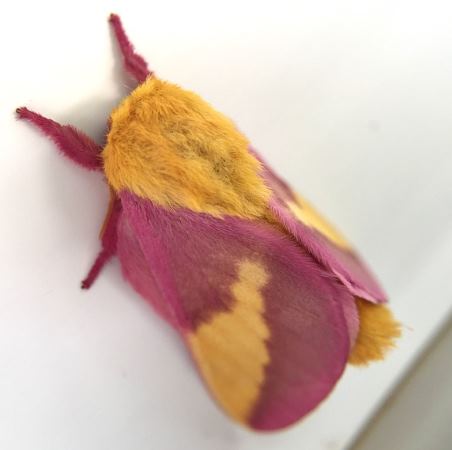
The beautiful fluffy rosy maple moth is easily identified by its colorful yellow and pink wings
The rosy maple moth is a stunning pink furry moth. It exhibits soft pink and creamy white hues on both its forewings and hindwings. With a compact and robust body, this moth typically has a wingspan ranging from 1.25 to 2 inches (3.2 to 5 centimeters). Its distinct coloration and furry, plump thorax and abdomen contribute to its unique and delicate appearance.
- Adult Stage: Transforms into the rosy maple moth
- Caterpillar Feeds on: Maple tree leaves, particularly those of the red maple
- Habitat: Found in woodlands and gardens where maple trees grow. Commonly seen in parts of North America
- Stinging: Does not sting
Imperial Moth Caterpillar (Eacles imperialis)
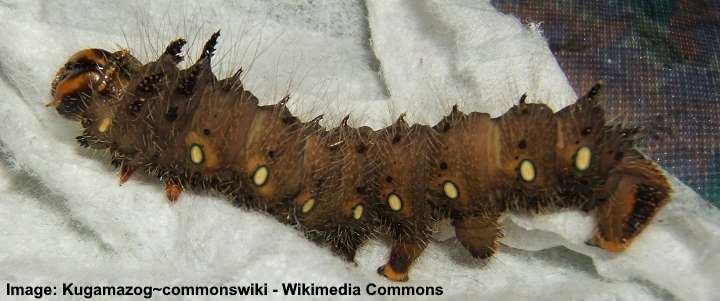
The large imperial moth caterpillar has dark brown body with spines and pale yellow spots along its sides
The giant imperial moth caterpillar is a large, dark brown worm-like insect covered in thin, wispy filaments with a row of yellow spots along its abdomen. The brown moth caterpillar has jagged-looking spines at its head and two rows of smaller spines along its back. The large brown caterpillar measures 5.5” (100 mm) long.
Imperial Moth

The imperial moth is yellow and brown and looks like autumn leaves
The imperial moth, scientifically known as Eacles imperialis, is a majestic and distinctive species known for its impressive size and striking appearance. With a wingspan that can reach up to 7 inches (17.8 centimeters), this moth is one of the largest in North America. Its wings feature a rich and varied color palette, including shades of yellow, orange, and purple, accompanied by intricate patterns and eye-catching markings.
- Adult Stage: Imperial moth
- Host Plants: Feeds on a variety of trees including oak, maple, and pine
- Habitat and Distribution: Found in forests and woodlands across North America, particularly in the eastern regions
- Stinging: The imperial moth caterpillar is not known to have strong stinging capabilities, although its spiny hairs may cause mild skin irritation in some individuals
Cecropia Moth Caterpillar (Hyalophora cecropia)
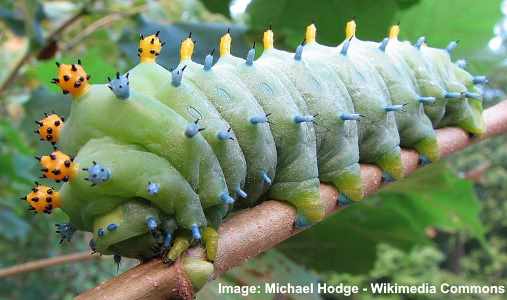
The Cecropia moth caterpillar is a large green caterpillar with yellow and blue nodules
One of the most unusual green moth caterpillars is the Cecropia moth larva. The lime green oversized, fat moth caterpillar with its bulging segments has rows of yellow and blue tubercles along its body. In addition, large orange ball-like spiny orange tubercles are found near its head.
This vast, menacing-looking but harmless moth caterpillar grows between 4” and 4.5” (100 – 110 mm) long. You’ll find the fat moth caterpillar feeding on leaves of beech, birch, cherry, dogwood, elm, poplar, willow, and oak trees.
Cecropia Moth
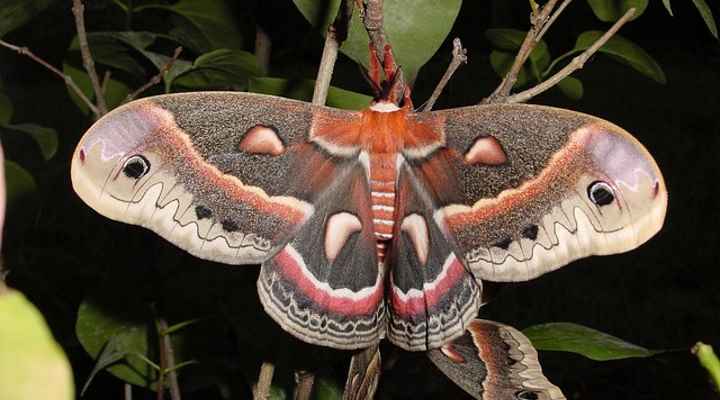
The large and colorful cecropia moth has stunning shades of brown, beige and orange patterns on its wings
The cecropia moth, scientifically known as Hyalophora cecropia, is a stunning and distinct species known for its large size and captivating appearance. With a wingspan that can measure up to 6 inches (15.2 centimeters), it is one of the largest moths in North America. The wings of the cecropia moth showcase a magnificent blend of colors, featuring hues of reddish-brown, white, and tan, creating an intricate and eye-catching pattern that contributes to its overall beauty.
- Adult Stage: Transforms into the cecropia moth
- Caterpillar Feeds on: Various deciduous trees and shrubs, including maple, birch, and cherry
- Habitat: Found in woodlands and forested areas where host plants grow. Common in parts of North America
- Stinging: Does not sting
Elephant Hawk Moth Caterpillar (Deilephila elpenor)

The elephant hawk moth caterpillar has gray-brown body and black spots
The elephant hawk moth caterpillar is dark-brown with black spots and the appearance of an elephant’s trunk. The speckled brown moth caterpillar has a brownish-gray body with eyespots near its head and a backward curving “horn” at its back. Fully grown moth larvae measure up to 3” (75 mm) long.
Elephant Hawk Moth
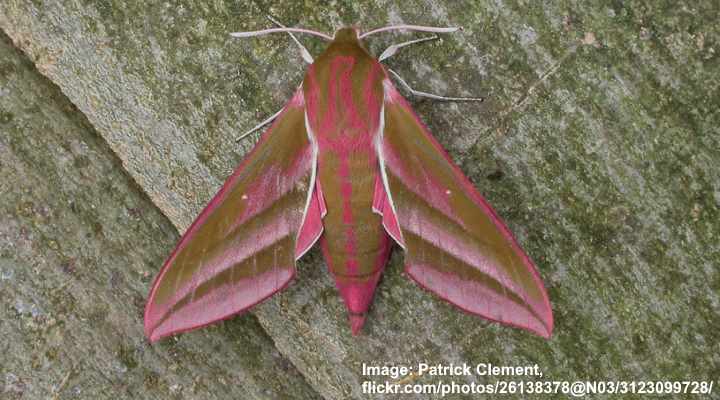
The attractive elephant hawk moth has pink and brownish wings and body
The elephant hawk moth, known scientifically as Deilephila elpenor, is a notable and distinctive species recognized for its sizable proportions and captivating appearance. It has a wingspan ranging from approximately 2.4 to 2.8 inches (6 to 7 centimeters). Its wings exhibit a blend of colors, often featuring various shades of pink, olive, and brown, arranged in intricate patterns that enhance its unique appearance.
- Adult Stage: Elephant hawk moth
- Host Plants: Feeds on various plants, including willowherb, bedstraw, and fuschia
- Habitat and Distribution: Found in various habitats such as gardens, meadows, and open areas, primarily across Europe, Asia, and parts of Africa
- Stinging: The elephant hawk moth caterpillar does not possess stinging capabilities or cause skin irritation
Tobacco Hawk Moth Caterpillar (Manduca sexta)

The tobacco hawk moth caterpillar is a type of large green caterpillar with horn at its end
Also known as tobacco hornworms, the sizable green moth caterpillar has diagonal white stripes along its sides to identify it. Apart from the diagonal striped markings, the green larvae have small horn-like protrusions at the end of the last abdominal segment, as well as tiny black and white eye markings along its sides. These moth caterpillars grow up to 3.1” (80 mm).
The tobacco hawk moth caterpillar looks like a tomato hornworm. The difference between the two caterpillar species is that the tomato hornworm is identified by its V-shaped markings, not diagonal white stripes.
Tobacco Hawk Moth

The tobacco hawk moth has brown-gray wings and yellow spots on its body
The tobacco hawk moth, scientifically known as Manduca sexta, is notable for its substantial size and striking appearance. With a wingspan typically ranging from 4 to 5 inches (10 to 13 centimeters), it is one of the larger hawk moth species. The wings of the tobacco hawk moth feature a fascinating combination of colors, including various shades of brown, beige, and olive, intricately arranged to create a visually stunning and distinctive pattern.
- Adult Stage: Becomes the tobacco hawk moth
- Caterpillar Feeds on: Tobacco, tomato, and other plants in the nightshade family (Solanaceae)
- Habitat: Found in gardens and agricultural fields. Common in North America
- Stinging: Does not sting
Funerary Dagger Moth Caterpillar (Acronicta funeralis)
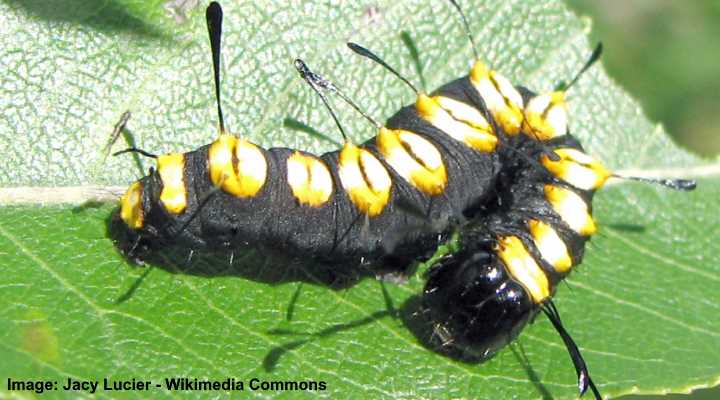
The funerary dagger moth caterpillar is also called the paddle caterpillar due to its paddle-like hairs
Also called the paddle caterpillar, the funerary dagger moth larva is a striking black caterpillar with large bright yellow markings. The unusual feature of this black moth caterpillar is the slender paddle-like protrusions from its jet-black body. The yellow and black moth larva grows up to 1.37” (35 mm) long.
Funerary Dagger Moth

The funerary dagger moth is gray and black with furry head
The funerary dagger moth, scientifically known as Acronicta funeralis, has a wingspan typically ranging from 1.5 to 2.2 inches (3.8 to 5.6 centimeters). Its wings display a unique combination of colors, often featuring shades of gray, brown, and white, forming intricate patterns that contribute to its distinct appearance. This moth is recognized for its compact and robust body, allowing it to blend seamlessly with its natural surroundings.
- Adult Stage: Funerary dagger moth
- Host Plants: Feeds on a variety of deciduous trees and shrubs, including oak, hickory, maple, and walnut
- Habitat and Distribution: Found in various habitats such as forests, woodlands, and suburban areas, primarily in North America
- Stinging: The funerary dagger moth caterpillar does not possess stinging capabilities or cause skin irritation
Regal Moth (Royal Walnut Moth) Caterpillar (Citheronia regalis)
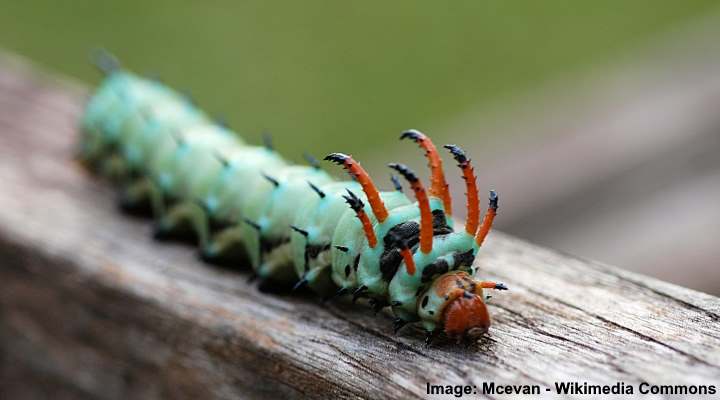
The regal moth caterpillar has a scary look with blue-green body and orange and black horns
The regal moth caterpillar is one of the scariest and largest types of moth larva you’ll find. The fat, turquoise-green moth caterpillar has orange or red-colored, black-tipped arched horns, rows of menacing black spines, and an orangey-red head. Fully grown, the royal walnut moth caterpillar grows up to 6” (150 mm) long.
Regal Moth
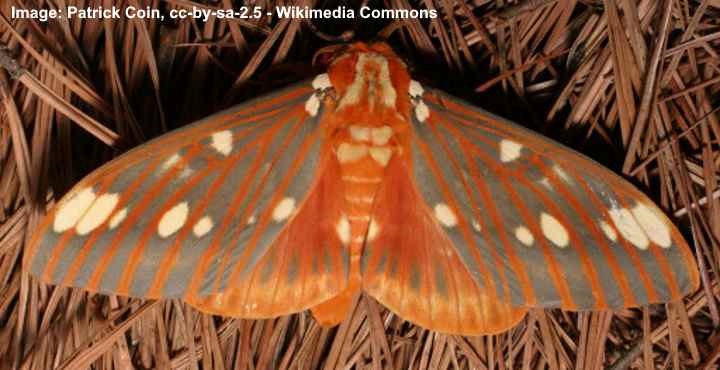
The beautiful regal moth has orange and gray wings with pale spots
The regal moth, scientifically known as Citheronia regalis, has a wingspan that can reach up to 6.5 inches (16.5 centimeters). Its wings feature various shades of brown, gray, and white, forming intricate patterns. This moth is characterized by its robust and powerful body, contributing to its regal and commanding presence.
- Adult Stage: Regal moth
- Host Plants: Primarily feeds on foliage of various trees such as hickory, walnut, sweetgum, and sumac
- Habitat and Distribution: Found in deciduous forests, gardens, and woodlands, primarily in North America, including the United States and parts of Canada
- Stinging: The hickory horned devil caterpillar does not possess stinging capabilities or cause skin irritation
Southern Flannel Moth (Puss) Caterpillar (Megalopyge opercularis)
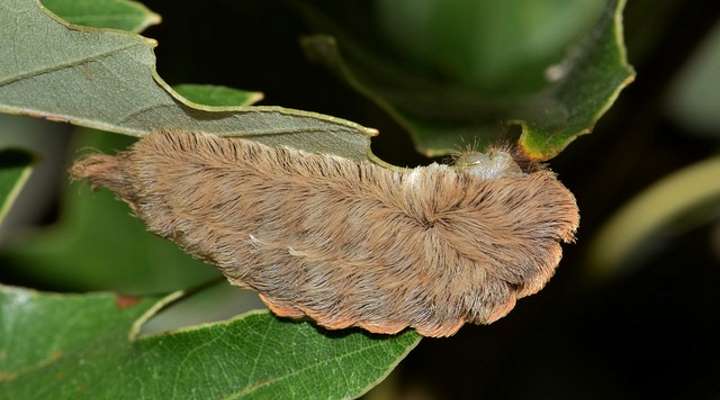
The small southern flannel moth caterpillar is one of the fluffiest types of furry caterpillars with light brown hairs
The southern flannel moth caterpillar looks brown, soft, and fluffy but is a type of stinging caterpillar. The hairy caterpillar ranges in color from golden orange-brown to dark gray. You’ll often notice an orange stripe running down its disheveled-looking body. The puss moth caterpillar measures up to 1” (25 mm) long.
The puss moth caterpillars are considered dangerous insects due to their nasty sting. Symptoms from the sting of a puss moth caterpillar can vary in severity and may include headache, nausea, fever, and seizures.
Other names for the southern flannel moth are Italian asp, woolly slug, puss mother, or asp caterpillar. These names refer to the caterpillar’s hairy appearance, like a tiny Persian pussy cat or its singing setae that resemble a snake bite.
Southern Flannel Moth
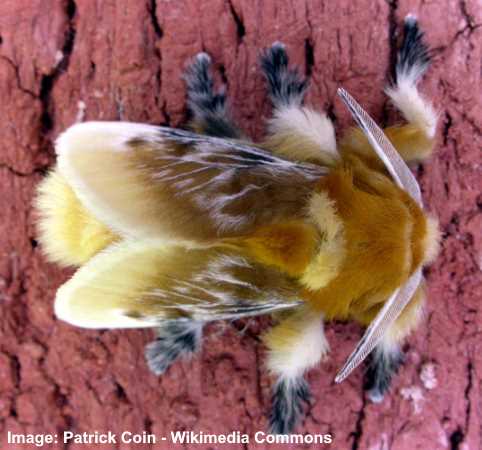
The fluffy southern flannel moth has furry body with brown wings and white edges
The southern flannel moth has a hairy appearance, fuzzy black feet and is typically covered in a furry coat in shades of brown, white, and orange. It also has distinctive white comb-like antennae.
- Adult Stage: Southern Flannel Moth Caterpillar transforms into the Southern Flannel Moth (Megalopyge opercularis)
- Host Plants: Puss caterpillars are commonly found on hackberry, elm, plum, sycamore, oak and rose
- Habitat and Distribution: Found in gardens, forests, and urban areas across the southern United States
- Stinging: Toxic stinging caterpillar that gives a nasty sting. Symptoms from the sting of a puss caterpillar can vary in severity and may include headache, nausea, fever, and seizures. Medical attention is advised if symptoms continue to worsen
Emperor Moth Caterpillar (Saturnia pavonia)
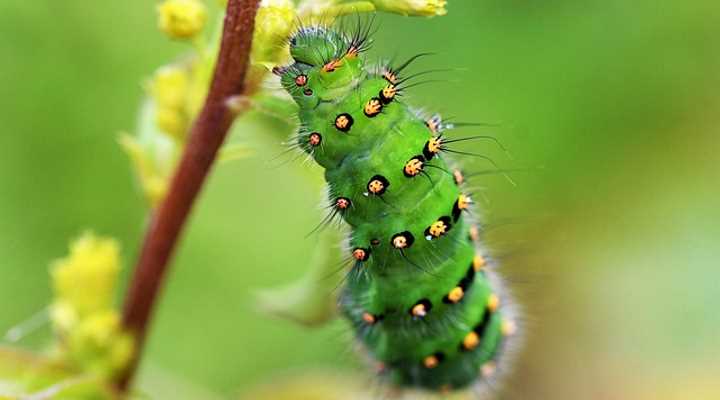
The emperor caterpillar has yellow and black dots on its large green body
The emperor moth caterpillar is a giant green segmented worm-like insect with transversal rows of hairy tufts emerging from black and yellow tubercles. Some varieties of these green moth caterpillars have thick black bands on a lime green body. The young moth caterpillars emerge black and orange and become green as they mature. Eventually, the mature green moth caterpillars grow a sizable length of 2.4” (60 mm).
Emperor Moth
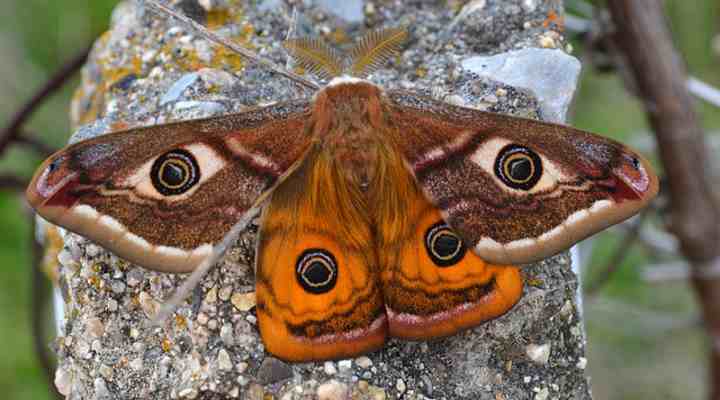
The attractive large emperor moth is active during the day and is characterized by its hairy body and brown and orange wings with eye markings
The emperor moth, known scientifically as Saturnia pavonia, is a notable and distinctive species recognized for its large size and striking appearance. With a wingspan that can measure up to 2.5 to 3 inches (6.5 to 7.5 centimeters), it is one of the larger moth species found in Europe.
The emperor moth is known for its distinct eye-catching eyespots on its hindwings, which serve as a form of mimicry to deter potential predators. These eyespots, resembling the eyes of a larger creature, create the illusion of a formidable presence, effectively deterring predators and enhancing the moth’s chances of survival in its natural environment.
The wings of the emperor moth feature a captivating blend of colors, often displaying various shades of brown, orange, and white, forming intricate and eye-catching patterns.
- Adult Stage: Develops into the emperor moth
- Caterpillar Feeds on: Various broadleaf trees and shrubs, including oaks, willows, and heather
- Habitat: Found in woodlands, heathlands, and other habitats where host plants grow. Common in parts of Europe and Asia
- Stinging: Does not sting
Luna Moth Caterpillar (Actias luna)
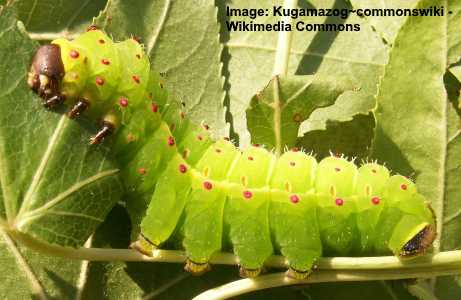
The large luna moth caterpillar has green ridged body with red dots
The luna moth caterpillar is identified by its oval brown head, six brown front legs, and rows of red spiny bumps. Also characteristic of this lime-green, almost translucent moth larva is its unusually large four pairs of prolegs. Just before pupation, the plump green moth caterpillar turns a reddish color.
Luna Moth

The green luna moth has tail-like hindwings and it looks like a leaf
The luna moth, scientifically known as Actias luna, has a wingspan that can reach up to 4.5 inches (11.4 centimeters). Its wings feature a captivating blend of pale green and yellow, creating a soft and delicate color palette. The Luna Moth is characterized by its striking, elongated tails on its hindwings, adding to its graceful and elegant appearance.
- Adult Stage: Develops into the luna moth
- Caterpillar Feeds on: Various broadleaf trees, including birch, sweetgum, and hickory
- Habitat: Found in forests and woodlands where host trees grow. Commonly found in eastern North America
- Stinging: Does not sting
Mullein Moth Caterpillar (Cucullia verbasci)
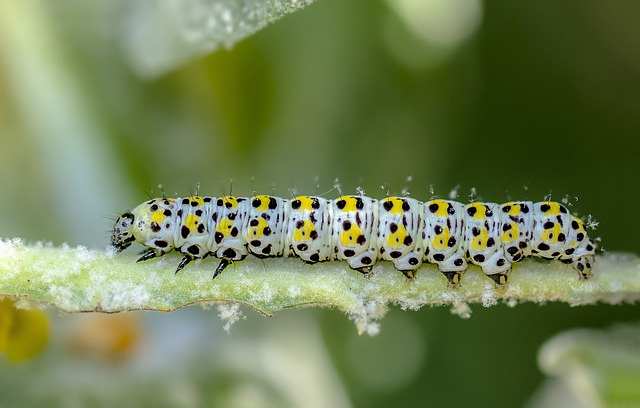
The beautiful mullein moth caterpillar is identified by its white or pale green body with black and yellow spots
The large worm-like creamy-white or pale grayish-green moth caterpillar has patches of yellow and black on its body. The mullein moth larva markings are yellow blotches with irregular black dots. Additionally, fine setae feature along the black and white caterpillar’s back. The moth caterpillar measures 2” (50 mm) and is easily recognizable.
Mullein Moth
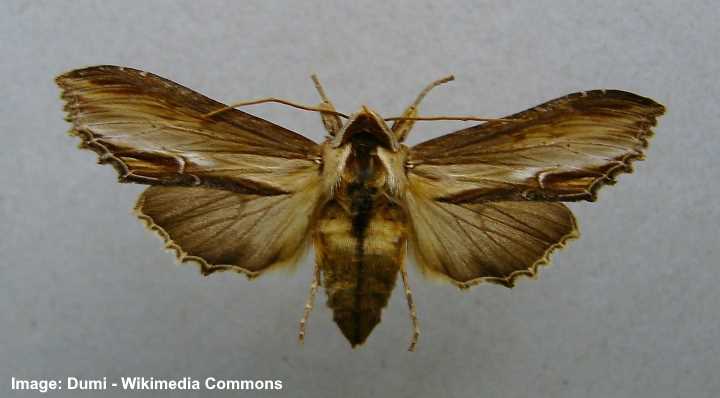
The mullein moth has brown patterns along its wings
The mullein moth, scientifically known as Cucullia verbasci, has a wingspan that typically ranges from 1.6 to 2.2 inches (4 to 5.5 centimeters). Its wings exhibit a combination of colors, often featuring shades of brown, gray, and white, arranged in intricate patterns. The mullein moth is characterized by its compact and robust body, allowing it to blend seamlessly with its natural surroundings.
- Adult Stage: Transforms into the mullein moth
- Caterpillar Feeds on: Primarily feeds on mullein plants (Verbascum species)
- Habitat: Common in North America and Europe, often in fields and meadows
- Stinging: Mullein moth caterpillars do not have stinging spines
Brown-Tail Moth Caterpillar (Euproctis chrysorrhoea)
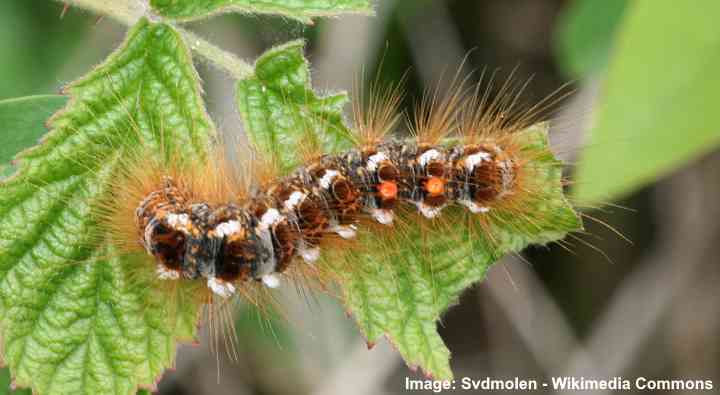
The brown-tail moth caterpillar has white marking and stinging hairs on its body
The brown-tail moth caterpillar is a reddish-brown caterpillar with rows of white patches and long stinging pencil hairs. Brown-tail moth larvae grow up to 1.5” (38 mm) long and are commonly found on birch trees, as well as ash, oak, maples, and various fruit trees.
Brown-Tail Moth

The brown-tail moth is hairy white with brownish furry tail
After emerging from the cocoon, the brown hairy caterpillars become stunning fuzzy white moths. As the name suggests, the brown tail moths have a recognizable brown tail, as well as two comb antennae, furry wings, and a fuzzy white head.
- Adult Stage: Brown-tail moth, a small, white moth
- Caterpillar Feeds on: Various deciduous trees and shrubs, including oak, apple, and cherry trees
- Habitat: Woodlands, gardens, urban areas; primarily found in Europe, including countries like the United Kingdom and parts of continental Europe
- Stinging: The brown-tail moth caterpillar has stinging hairs on its body that can cause skin irritation upon contact
Diamondback Moth Caterpillar (Plutella xylostella)
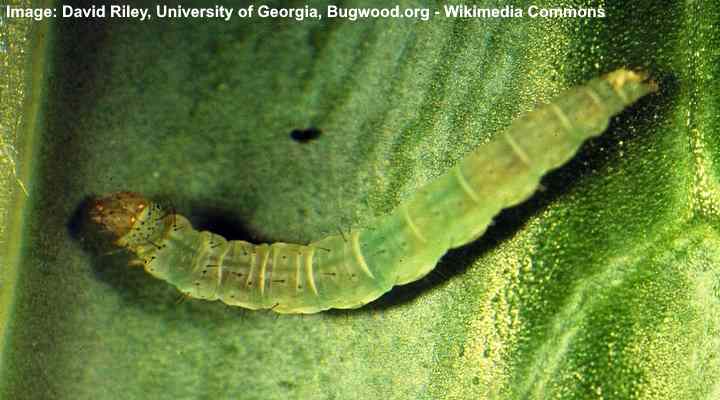
The small pale green diamondback moth caterpillar has dark head and tiny black hairs on its body
The diamondback moth caterpillar is a slender, worm-like green insect with a sparse covering of black spiny hairs and V-shaped rear end. Other features of this green caterpillar are a dark-colored greenish-brown head, irregular whitish dots, and faint yellow bands between its segments. The small green moth grows up to 0.4” (11 mm) long.
Diamondback Moth
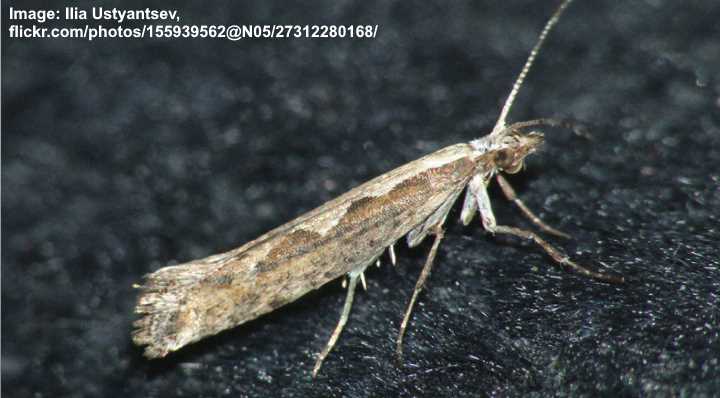
The slender diamondback moth is gray-brown and has a short life-cycle
The diamondback moth emerges as a type of leaf-mining larva and destroys the leaves of various kinds of trees and shrubs. When the caterpillar becomes a moth, it’s a slender grayish-brown flying insect with long pointed antennae. The moth’s wingtips have a lightly-colored band and turn upward slightly.
- Adult Stage: Develops into the small diamondback moth
- Caterpillar Feeds on: Various cruciferous plants, including cabbage and broccoli
- Habitat: Found in agricultural fields and gardens. Common and found worldwide
- Stinging: Does not sting
Cinnabar Moth Caterpillar (Tyria jacobaeae)
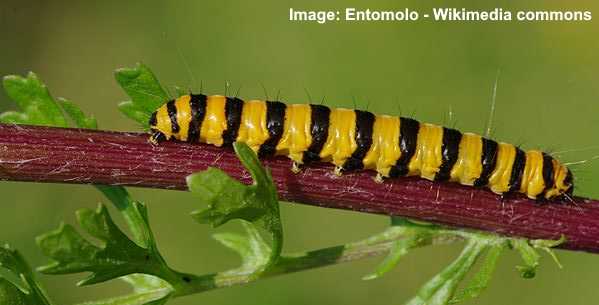
The cinnabar moth caterpillar has yellow and black stripes with fine hairs on its body
The stunning caterpillar of the cinnabar moth is a bright yellow and black striped larva with a glossy sheen to its body. The stripy body is sparsely covered in black and white spines. Its dramatic contrasting colors warn predators to stay away from this poisonous insect. The cinnabar moth caterpillar grows 1.2” (30 mm) long.
Cinnabar Moth

The beautiful cinnabar moth has bright red and black wings
The cinnabar moth, scientifically known as Tyria jacobaeae, features wings that display vibrant shades of red and black, forming intricate patterns. With a wingspan typically ranging from 1.2 to 1.6 inches (3 to 4 centimeters), it is a medium-sized moth species. The cinnabar moth is characterized by its relatively robust and compact body, contributing to its distinct and recognizable appearance.
- Adult Stage: Transforms into the cinnabar moth.
- Caterpillar Feeds on: Feeds on ragwort plants (Senecio species)
- Habitat: Common in Europe, often in grasslands, meadows, and areas with ragwort plants
- Stinging: Cinnabar moth caterpillars do not have stinging spines
Io Moth Caterpillar (Automeris io)
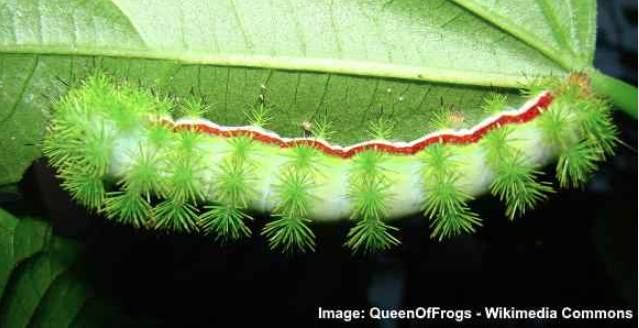
The Io moth caterpillar has green spikes that feel very unpleasant if their venom penetrates your skin
Io moth caterpillars grow up to 2.3” (6 cm) long. They emerge from the eggs a rusty-brown color with thin black stinging hairs. The venomous caterpillars gradually turn green and develop the characteristic stinging needle-like green tufts that look like pine needles.
The spines of io moth caterpillar contain toxic substances that cause a lot of skin irritation. The urticating spines can give you a nasty “bite” if the venom gets into your skin. Even just the slightest touch of these stinging caterpillars can cause a lot of pain that lasts an hour or so.
You can identify this species by the red and white stripes running the length of its side. Green spikes stick out from all parts of its body. There are even tiny spikes on the 4 pairs of prolegs on its central segments.
Io Moth
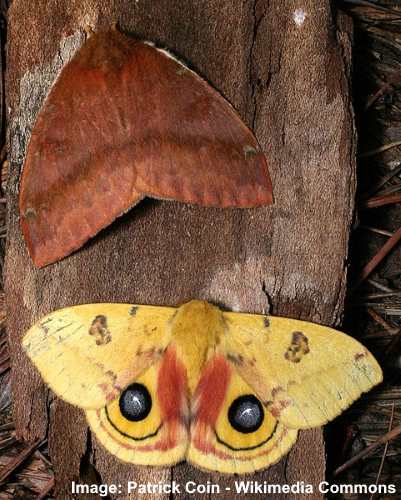
Io moth (Automeris io): female (top) and male (bottom)
The Io Moth, scientifically known as Automeris io, features wings with captivating shades of yellow, pink, and cream, forming intricate patterns. With a wingspan that can measure up to 2.5 to 3.5 inches (6.4 to 8.9 centimeters), it is one of the larger and more notable moth species. The Io Moth is distinguished by its prominent eyespots on its hindwings, which serve as a form of mimicry to deter potential predators. These eyespots create the illusion of a formidable presence, effectively deterring predators and enhancing the moth’s chances of survival in its natural environment.
- Adult Stage: Transforms into the io moth
- Caterpillar Feeds on: Various plants, including oak, willow, and cherry
- Habitat: Found in woodlands, gardens, and open areas. Common in parts of North America
- Stinging: May deliver a painful sting if handled
Related articles:
